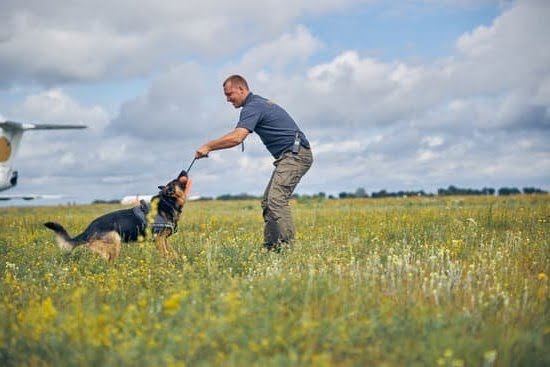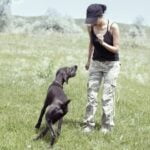Introduction
Dog training aids to stop pulling can be incredibly beneficial for any dog owner. Teaching a dog to stop pulling is arguably one of the most important lessons any pup must learn. Not only is it an important life skill, but it is also vital for safety reasons. Teaching a pup to properly walk on a leash without tugging or pulling at their owner’s arm is imperative and can make outdoor walks much more enjoyable for both the pup and their human companion.
There are several training techniques that can be used to help teach a pup how to walk on a leash without pulling, using both positive reinforcement and negative punishment methods. Utilizing specialized dog leashes, harnesses, head collars, easy-walkers and no-pull leashes are just some of the many training aids available that can aid in obedience and corrective behavioral modification. Additionally, providing rewards such as treats or verbal praise when the desired behavior is displayed will ensure continual progress. Furthermore, finding what works best for both you and your pet may prove to be an invaluable process when it comes to successful leash training.
The Challenges
When it comes to training a dog not to pull, there are many challenges that can affect a pet’s understanding of the desired behavior. Breed is a major factor in determining how much effort will be needed to achieve the desired result. Some breeds have an inherent stubborn streak and may need extra patience, persistence, and understanding.
Age is another factor to consider because dogs develop at different speeds, sometimes until they reach full maturity. Puppies especially may take longer to learn not to pull as their attention span and focus is shorter than that of an adult pet. Additionally, size can influence the challenge of teaching a dog not to pull on their leash, as larger dogs often have more strength and can create more pulling force when excited or curious how small breeds. Finally, past experiences and environmental factors can either hinder or help in the training process depending on prior interactions with other animals or people.
Training Tools
Leashes: Leashes are one of the most common tools used to help train a dog to stop pulling. The key is to choose a leash that is strong enough to withstand the pull of your dog, and one that is comfortable for both you and your canine friend. Choose a leash in an appropriate length; too long of a leash may encourage your pup to take control, while too short of a leash may cause strain and discomfort.
Harnesses: Harnesses offer more control over the power of your dog’s pull, as well as eliminating any neck strain caused by a collar. Harnesses are ideal for those who would like an extra layer of control when walking their pup, but do require an extra amount of time for training – some pups may need several days or weeks to adjust! However, in the long-run, it can be well worth the effort.
Collars: Collars come in all shapes and sizes depending on what type you buy – there’s nylon webbing collars, chain slip collars, flat buckle collars and much more! Although they are mostly used for identification purposes most owners also use them to prevent their pup from pulling on the leash by providing more direct control on their dog’s behaviour.
Treats: Positive reinforcement through treats can provide excellent results with helping train your pup how to remain calm while being walked on his/her lead. The key here is finding small treats that are not overly calorific – think bits of carrot, banana or peanut butter! This will ensure that your pup stays motivated without being over-fed!
Using Harnesses Effectively
There are a few different types of harnesses which can help reduce the pulling of a dog. The traditional design is a head halter, like the Gentle Leader or Halti Harness. This type safely and securely clamps around the jaws to redirect your pooch when they become overactive, controlling the movement of your pup’s whole body with gentle pressure on their neck and chest. The next option is front-attaching harnesses which have one connection point in front of your pup’s shoulders that clips to their leash. These harnesses can be great for teaching leash walking basics and discourage over-excited behavior because you have more control from the front position than from behind. Lastly, there are rear-attaching harnesses (also called “no pull” harnesses) which attach around your pup’s torso, aiming to prevent excessive pressure on their throats while they pull.
To effectively use a harness it’s important to make sure it fits correctly! You want a snug fit but should make sure not to make it too tight as it may cause discomfort and even pain if done incorrectly. Additionally, begin training your pup to wear the harness at home before going out for walks, using positive reinforcement while putting it on them and praising them after they wear it correctly. Lastly, be patient during walks–mentally prepared that their pulling may still occur despite how well fitting the harness is–and use distraction techniques such as treats or interactive toys if needed to reduce pulling behavior.
Understanding Leash Etiquette
One way to help a dog learn leash etiquette is by starting with a solid foundation in basic obedience. Teaching your dog the following cues can help him understand what appropriate behavior looks like and reinforce self-control without yanking or jerking on the leash: sit, down, come and stay. Understanding commands such as these will enable you to easily stop your dog when he starts to pull, giving you essential control over the situation.
Coaxing with treats can be a great method of training dogs to walk politely on a leash. Set up regular rewards while walking, either using an automatic treat dispenser or manually handing out treats as prompted from verbal cues from yourself. Increase the proximity of the reward as your pup tunes into your commands and prompt new behaviors until he can walk steadily beside you for extended periods at a time. Good reinforcement helps cement desired behaviors in place.
If you find that guiding your pup with treats is not enough for tighter leash control, incorporate other aids into your practice like head collars or harnesses which limit your dog’s ability to pull forward or backward. These need to be used appropriately; never leave them on if you are not actively practicing—they can cause discomfort and fur loss over prolonged use without proper guidance/breaks or if incorrectly fitted/adjusted. Finally, using distraction techniques such as spin commands or squeaking toys near their face while they pull will help dissolve their interest in straining against the leash when out on walks
Positive Reinforcement Training
Positive reinforcement training is a key part of dog training when it comes to making sure that your pup learns quickly and efficiently. Positive reinforcement works by providing the dog with a reward for positive behaviors, such as going for a walk without pulling or following commands. This reward technique helps encourage good behavior, while punishing bad behavior is less likely to lead to learned and lasting results.
Training should start in a controlled environment like an enclosed yard or driveway. Teaching loose-leash walking should begin in this area, as well as basic commands like sit and stay. Short walks on the leash might be fine when adding distance, but eventually he must learn that tugging isn’t allowed. If the pup pulls at any time during the walk, simply stop until his attention returns to you, then turn around and re-start in the opposite direction. Providing abundant praise for heel position can help keep him motivated and focused throughout short walks.
For longer walks where more (called ‘distracting’) stimulus is present it becomes more difficult but not impossible! Using treats intermittently will continue to motivate them during these because treats are all that matters during these walking sessions! Additionally using tab tethers can act as an obstacle course, so they must stay closer while they navigate through tight spaces between obstacles – redirecting their focus onto you! And lastly offering additional physical exercise prior and/or following each walk will also help tire out mental energy which leads to less pulling when up on the leash!!
Behavior Modification
Behavior modification is an effective way to stop dogs from pulling. It involves reinforcing good behavior and discouraging bad behavior, which results in a reduction of unwanted behaviors like pulling on the leash. Some techniques that can be employed include using verbal or physical cues like saying “No” firmly, or stopping and taking a few steps back each time the dog pulls ahead of you on a walk. Turning away and pausing when your dog pulls is also an effective form of discouragement and will teach the dog that it cannot go anywhere if he does not walk nicely beside you. In addition, positive reinforcement such as providing treats for walking calmly can be used to encourage appropriate behavior in the future. Creating a dynamic where owners treat their dogs with consistency and patience helps dogs learn more quickly and makes training easier in the long run.
Working with Professionals
Working with professionals is an important part of training a dog to stop pulling. A professional dog trainer will be knowledgeable in animal behavior, have experience in handling dogs, and be able to provide instruction tailored specifically to the needs of the pet. They will also be familiar with techniques and tools used by trainers to teach dogs how to walk on a leash correctly. Additionally, an experienced professional can help owners troubleshoot any stubborn problems or issues that may arise throughout the training process. Working with other experts such as veterinarian behaviorists may also benefit as they can help diagnose underlying medical reasons for misbehavior on leash. Ultimately, utilizing the help of professionals when attempting to train a dog will reduce frustration for both owner and pet alike and allow for success more quickly than using self-taught methods alone.
Conclusion
Using a variety of dog training aids to stop your pet from pulling is a great way to ensure the wellbeing of both you and your pup. All of these aids are designed to make the process of teaching your dog not to pull easier and more consistent. No-pull harnesses, head collars, prong collars, and remote collar systems all have the potential to help teach a dog not to pull on their leash. All of these products come with instructions for correct use and should be used in conjunction with positive reinforcement methods for best results. Utilizing these tools will provide you with an effective way to train your pup that is safe and reliable while also promoting their overall wellbeing.

Welcome to the blog! I am a professional dog trainer and have been working with dogs for many years. In this blog, I will be discussing various topics related to dog training, including tips, tricks, and advice. I hope you find this information helpful and informative. Thanks for reading!





